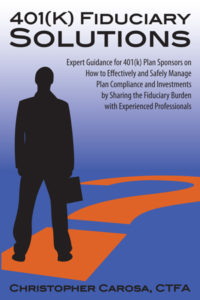How Johnson v. Parker-Hannifin Impacts Professional Fiduciaries And 401k Plan Sponsors

This might seem like an odd thing to feature in an article, but the potential repercussions can offer a significance worth discussing. Parker-Hannifin Corporation found itself in the crosshairs of a handful of current and foreign employees. The case, known as “Johnson v. Parker-Hannifin Corp.,” case, was filed in the United States District Court for the Northern District of Ohio, Eastern Division. In it, the plaintiffs alleged Parker-Hannifin failed to prudently monitor investments, leading to high-cost share classes.
The court dismissed the case, but Johnson et al. didn’t give up. They asked the United States Court of Appeals for the Sixth Circuit to review the case. This court determined the plaintiffs’ case had merits and remanded the case for further proceedings.
Jack Towarnicky, of counsel for Koehler Fitzgerald, LLC in Powell, Ohio, says, “The opinion summary also found: ‘The court also found that the plaintiffs plausibly alleged that Parker-Hannifin failed to negotiate for lower-cost shares, which could constitute a breach of the duty of prudence.’ In the background discussion regarding fees, the Court noted:
‘… From 2015 to 2019, Parker-Hannifin invested in the Focus Funds’ K share class, which had a 0.07% fee. During that time, however, there was a J share class “with a substantially lower fee of 0.02%’ available. Id. ‘The .05% fee difference between the Focus Funds’ K and J shares was the only distinction between the two shares.’ Parker-Hannifin’s ‘failure to utilize the available, lower-cost share class of the Focus Funds caused the Plan to pay as much as 250% more in fees.’
Likewise, Parker-Hannifin invested in Vanguard Funds’ share classes with fees ranging between 0.01% and 0.03% higher than Vanguard’s lower-cost share classes. ‘ [l] ower-cost share classes of the Plan’s investments were readily available.’ To the extent that the Plan’s assets did not meet ‘advertised minimum investment thresholds for the lowest-cost institutional shares, the investment provider would have waived those requirements based on the Plan’s size, if the Defendants had requested such a waiver.’
“While a 1 or 3 basis point difference may or may not be substantial, this is more about selecting the lowest share class available. So, no surprise that the 6th Circuit remanded the case to the district court to confirm whether or not lower share classes were available.”
The focus on fees associated with different share classes makes the suit more viable. Generally, it’s difficult to proceed in lawsuits involving performance.
“The principles for benchmarking passive index funds are no different than the principles for benchmarking actively managed funds, and note also the Sixth Circuit’s statement that a plaintiff can establish an imprudent process without necessarily establishing a meaningful benchmark as a comparator,” says Marcia S. Wagner, founder of The Wagner Law Group in Boston, Massachusetts. “It is difficult to establish a meaningful comparator, which is the reason that many of these suits are dismissed at the motion to dismiss stage. A plan fiduciary should benchmark passive funds, as well as actively managed funds, but the plan fiduciary will need to rely on its expert advisors to determine if the strategies of the passively managed funds are comparable, and should not look solely to the returns.”
Still, it doesn’t mean you cannot use performance as a canary-in-the-coal-mine type of indicator.
“If the differences in performance were significant, those differences could be evidence of a failure to appropriately monitor,” says Towarnicky. “That is, the initial selection of the investment may have followed a prudent process. To quote the opinion summary: ‘The appellate court held that the plaintiffs sufficiently pleaded facts to state a claim for imprudent retention of the Focus Funds, noting that the funds’ high turnover rates and underperformance could indicate a flawed decision-making process.’ If your goal is to avoid the plaintiff’s bar and today’s endemic litigation environment, you may want to consider actions that minimize fees and the differences between the performance of your passive investments and the related index. Following the 2012 fee disclosure regulations and ongoing fee litigation environment, the focus on fees (as opposed to a focus on performance, net, net of fees) clearly discourages any investment with high fees or performance that doesn’t match a passive strategy. Seventeen years ago (2006), we changed from mutual funds to collective investment trusts, and fifteen years ago (2008), we changed from an asset management fee to per capita and transaction fee charges for administrative costs. Both changes were designed to ensure passive investment tracking error was minimized and passive investment performance (both positive and negative) closely matched the index.”
What’s one way 401k plan sponsors can ensure they establish a due diligence framework that can best reduce their fiduciary liability?
“It is a best practice to adopt and maintain a plan investment policy statement (IPS) and to follow the IPS when making plan investment decisions,” says Michelle Capezza, of counsel for Mintz, Levin, Cohn, Ferris, Glovsky and Popeo, P.C. in New York. “The IPS can set parameters for the diversified mix of investment options that are to be offered in the plan, specify meaningful benchmarks to be used for the comparisons of the various investment options and their performance, and define the process to evaluate and monitor investments and place them on a watch list or remove them. In order to defend any challenges to their decision-making, plan fiduciaries must be able to at least point to an established prudent procedure that they followed and should ensure that they are engaged in ongoing discussions and evaluations with their plan investment advisors concerning the performance of the investments compared to meaningful benchmarks and whether they continue to fit within the guidelines of the IPS.”
But an IPS alone can’t offer foolproof protection.
“With respect to investment retention credit, while technically not legally required under ERISA, it is a best practice to have an IPS that, among other things, sets forth the criteria for evaluating investments, and frequently also addresses how long that a fund should be retained on a watch list,” says Wagner. “However, these are judgment calls based upon a number of factors, so it would not necessarily be appropriate to replace a fund merely because it has underperformed for x quarters. An investment policy statement might list a series of factors that the investment advisor should take into account in evaluating a plan’s investments and, if in the past has not been taken into account, it will probably be necessary to do so because of this Sixth Circuit Decision, but it is only one factor among many that an advisor needs to take into account. With respect to seeking alternative investment options to mitigate high turnover costs in one fund, it is necessary to view a plan’s investment portfolio holistically in evaluating whether an alternative investment structure is appropriate.”
“… A VITAL REFERENCE TOOL FOR YEARS TO COME.”
401(K) FIDUCIARY SOLUTIONS ADDRESSES THE FIVE KEY AREAS OF FIDUCIARY LIABILITY FACING 401K PLAN SPONSORS ON A DAILY BASIS. IN ADDITION, 401(K) FIDUCIARY SOLUTIONS FEATURES SEVERAL CHECKLISTS 401K PLAN SPONSORS CAN USE TO HELP ENSURE THEIR PLAN IS THE BEST IT CAN BE.
WOULD YOU LIKE TO DISCOVER THE COLLECTED WISDOM OF DOZENS OF INDUSTRY EXPERTS AND THOUGHT LEADERS? CLICK HERE AND BUY YOUR COPY OF 401(K) FIDUCIARY SOLUTIONS TODAY!
Fortunately, plan sponsors don’t have to go it alone in this regard.
“Plan investment advisers can play a key role in assisting plan sponsors and benefits committees in negotiating investment fee structures and share classes for plan investment options,” says Capezza. “A prudent diligence effort must be made to determine the reasonableness of fees and investment options for the size of the particular plan. Ongoing monitoring of the overall fee structure that is discussed in committee meetings should be documented in the meeting minutes and investment review decks should be maintained with plan records. On a go forward basis periodic checks on service and investment fees, share classes, and any revenue share arrangements should be conducted with the plan investment advisor to determine the appropriate time when there is sufficient leverage to negotiate fee reductions or more desirable share classes and arrangements as the plan assets grow in size.”
Here’s one aspect that might make Johnson v. Parker-Hannifin Corp. difficult to apply across the board. The opinion provides the following reason why the plaintiffs have a legitimate case when it states: “Given the Plan’s $4.3 billion in assets, it ‘had tremendous bargaining power to obtain share classes with far lower costs.’” Not all 401k plans have that same “bargaining power.”
“Only a limited number of plan sponsors will have the necessary bargaining power to negotiate a lower fee class for a plan,” says Wagner. “If a plan sponsor has or arguably believes that it falls into that category of plan sponsors, it should have that item on its to do list when it is engaged in contract negotiations with a platform provider. Documentation of the negotiation process will likely be dismissed by a Court as self-serving and conclusory but, for whatever benefit such documentation might have in litigation, a plan sponsor that has or arguably has sufficient bargaining power should memorialize its contract negotiations, and explain why negotiations were not successful or whether it had considered requesting a different feed class but had reasons for not pursuing it.”
What steps can 401k plan sponsors take to better protect themselves?
“Fiduciaries should carefully evaluate benchmarks based on the investment objectives of the plan and ensure they align with the expectations of passive fund management,” says Harold Evensky, founder of Evensky & Katz in Lubbock, Texas. He suggests these “steps to ensure alignment: Benchmarks should be selected based on their similarity to the fund being evaluated. As a beginning, fixed income should be compared to the quality of the bond holdings and the funds’ duration. Equity funds to size (e.g., large-cap, mid-cap, small-cap, micro-cap) and style (e.g., growth, core, value). Both are reviewed for historical drift (e.g., small-cap drifting to mid or large cap, value drifting to core or growth); Once the choices are narrowed down, next is a review of turnover and management cost; A review and comparison of risk-adjusted performance during historical bull and bear markets and over 3-, 5- and 10-year periods; A review of manager tenure. The reviews noted above should correspond to the period the current managers were in charge; Analyze any deviations (e.g., turnover, expenses, risk metrics, managers), ensuring they are justifiable and consistent with the strategy. All of the above needs to be documented in detail.”
It’s important to remember this issue is not just the existence of a solid due diligence process. It’s also about execution.
“This case does not affect the process for monitoring a plan’s fiduciaries with responsibility for a plan’s investments,” says Wagner. “It simply increases the items that the monitoring plan fiduciary to include additional items such as high turnover costs. The only caveat here is that if a plan sponsor did not seek to take advantage of its bargaining power in contract negotiations, that arguable breach of fiduciary duty is not easily remedied.”
Professional fiduciaries and plan sponsors might serve themselves well by paying close attention to what happens next in this case.
What do you think? Join us every Wednesday at noon (Eastern Time) for our Thought Leader Roundtable discussion. Not sure if you’re on the email invite list? Click here to be added to the list.
Christopher Carosa is an award-winning online news producer and journalist. A dynamic speaker, he’s the author of 401(k) Fiduciary Solutions, Hey! What’s My Number? How to Improve the Odds You Will Retire in Comfort, From Cradle to Retirement: The Child IRA, and several other books on innovative retirement solutions, practical business tips, and the history of the wonderful Western New York region. Follow him on Twitter, Facebook, and LinkedIn.
Mr. Carosa is available for keynote speaking engagements, especially in venues located in the Northeast, Mid-Atlantic, and Midwestern regions of the United States and in the Toronto region of Canada.










There are no comments at the moment, do you want to add one?
Write a comment